Calf Pain
There are two muscles that make up the calf complex or calf muscles, the Gastrocnemius and the Soleus. These muscles form the Achilles tendon that attach to the heel bone. These muscles are located on the back of the low leg and allow you to go up on your tip toes. Wearing high heels, or participating in activities where you are up and down on the ball of your foot can lead to the formation of knot spots. Muscle knots in the calf muscle can cause heel pain or pain in the bottom of the foot. Those who suffer from plantar fasciitis often find relief by working on the knot spots in the calf muscles.

Causes
Wearing High Heels: Wearing high heels forces the calf muscles into a shortened, contracted position, making them highly susceptible to developing muscle knots. These tight knots, especially in the gastrocnemius and soleus, can then cause aching pain in the calves and even refer discomfort up into the Achilles tendon or down into the foot. Over time, this chronic shortening and muscle knot formation can lead to persistent calf pain, Achilles tightness, and general foot discomfort when not wearing heels.
Walking or Running on Uneven Surfaces: Walking or running on uneven surfaces demands constant micro-adjustments from your calf muscles to maintain balance, leading to their overuse and a higher likelihood of developing muscle knots. These muscle knots in overworked calf muscles can then contribute to instability, making you more prone to ankle rolls or strains, and causing sharp or dull pain in the lower leg. The constant stress on already knotted muscles from uneven terrain exacerbates calf soreness, shin splints, and overall leg fatigue.
Worn Out Shoes: Worn-out shoes offer inadequate support and cushioning, forcing the calf muscles to work harder to stabilize the foot and absorb impact, thereby increasing the risk of forming painful muscle knots. These muscle knots in the calves can then lead to foot pain, arch pain, or even plantar fasciitis as the calves pull on connecting tissues and don’t properly support the foot. The lack of proper footwear support means the calf muscles are constantly under stress, perpetuating the cycle of muscle knot formation and chronic lower leg pain.
Hyperpronation: Hyperpronation, or excessive inward rolling of the foot, places unnatural strain on the calf muscles, particularly the soleus, making them highly prone to developing restrictive muscle knots. These muscle knots in the overstretched and overworked calf muscles can then cause a deep ache along the inside of the lower leg and contribute to shin splints and plantar fasciitis due to altered biomechanics. This can also lead to chronic calf tightness and persistent lower leg pain, often felt as a nagging ache after activity.
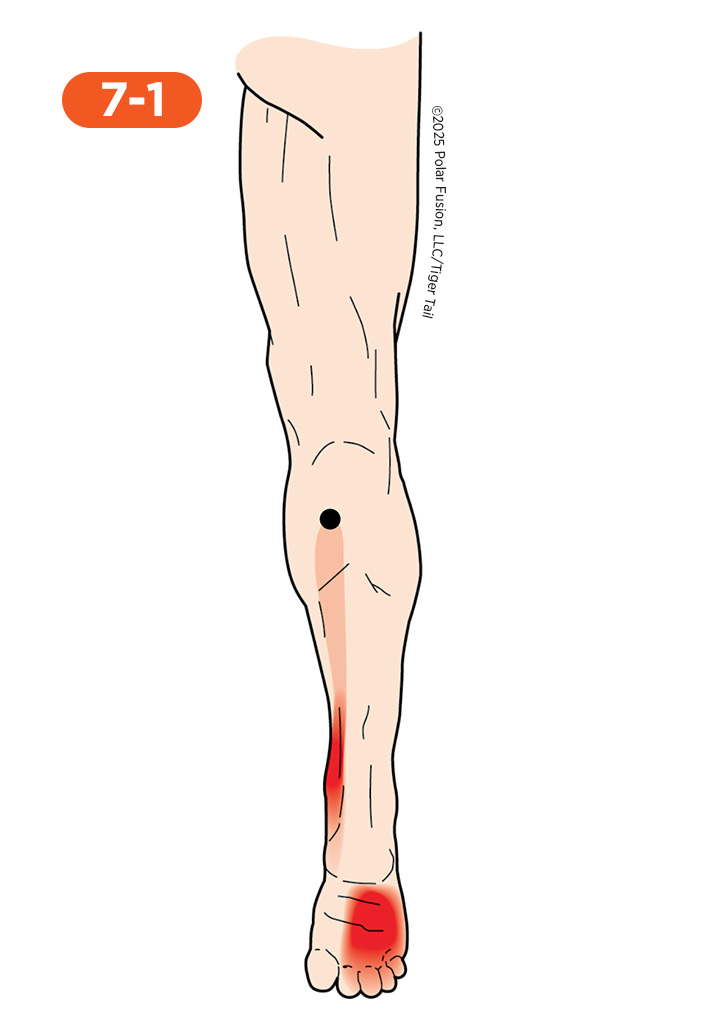
I Feel
Pain on the Inner Calf
That sharp pain you feel in your inner calf can be caused by muscle knots in the toe-curling muscle, the flexor digitorum longus. The discomfort usually focuses along the midline of the inner lower leg, presenting as a deep, nagging ache that sometimes runs along the inner ankle bone and into the arch of the foot. You’ll find the pain gets worse when you’re doing activities that grip your toes or load the arch, like walking barefoot on hard surfaces, pushing off to sprint, or wearing shoes with poor arch support. Because the flexor digitorum longus runs deep beneath the larger calf muscles, its knotting can easily mimic deeper problems, such as tibialis posterior tendonitis or even a stress reaction. The inner calf tissue can leave the lower leg feeling tight and restricted, limiting your ankle movement and toe flexion.
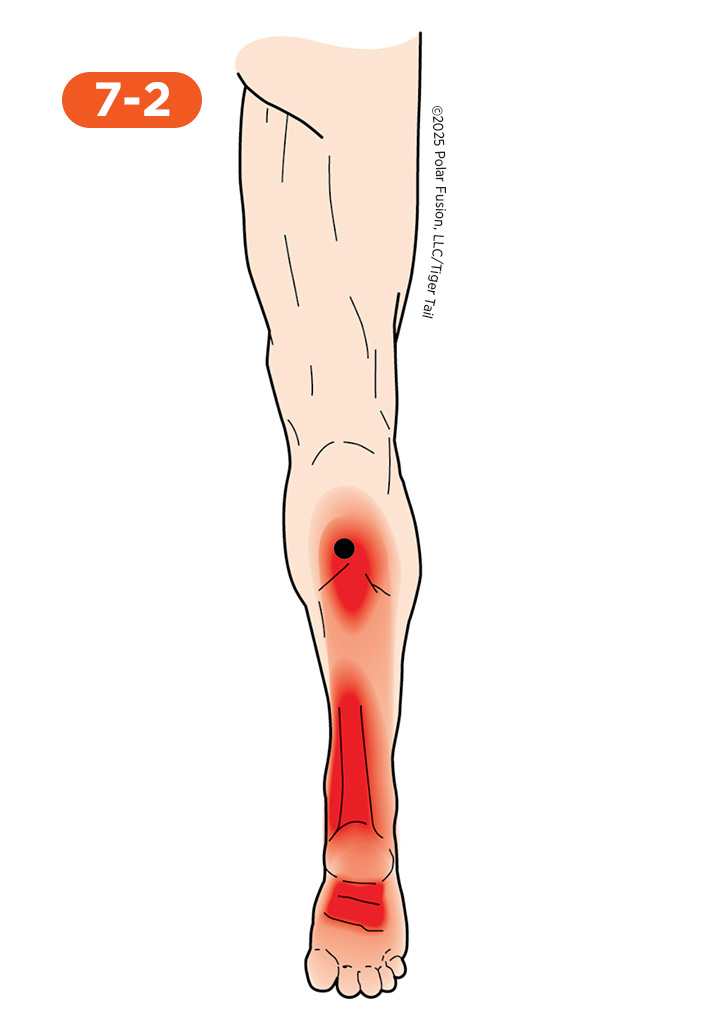
I Feel
Achilles Tendonitis
When you feel what exactly resembles Achilles tendonitis, the issue might be deep muscle knots in the workhorse of your lower leg, the tibialis posterior. The discomfort usually focuses on the inside of the ankle and behind the inner ankle bone, presenting as a deep, sharp ache that can sometimes run along the inner edge of the shin. You’ll find the pain gets worse when you’re doing activities that flatten the arch, like standing on one leg, running on uneven terrain, or walking long distances. Because the tibialis posterior stabilizes the ankle and arch, its knots can easily mimic deeper problems like true Achilles issues or tarsal tunnel syndrome. The tibialis posterior muscle is often susceptible to pressure, leaving the ankle feeling tight and unstable, especially when bearing weight.
Shin Splints
If you’re dealing with what feels like shin splints along the inside edge of your leg, the cause is often chronic muscle knots in the deep stabilizing muscle, the tibialis posterior. The discomfort usually focuses along the inner back edge of the shin bone, presenting as a deep, pulling ache that can spread throughout the lower inner leg. You’ll find the pain gets worse when you’re doing impact activities, like running or jumping, going up stairs, or stepping off a curb. Because this muscle helps support the arch and stabilize the lower leg, its muscle knots can easily mimic deeper problems, such as medial tibial stress syndrome (true shin splints) or a stress fracture. It can leave the lower leg feeling tight and restricted, especially during repetitive foot movements.

I Feel
Calf Cramps
When you experience painful calf cramps, the root cause is often chronic muscle knots in the large, visible outer calf muscle, the gastrocnemius. The pain typically concentrates high up in the muscle belly and feels like a sharp, intense cramping that can seize the entire muscle and extend along the Achilles tendon. The pain worsens during activities that rapidly stretch the muscle, such as standing up quickly in the morning, flexing your foot hard, or jumping. Since this muscle crosses both the knee and the ankle, its knots can easily mimic deeper issues like a muscle tear or deep vein thrombosis (DVT), which is a serious condition. It causes the calf to feel tight and restricted, leading to stiffness, especially in the morning.
Night Time Calf Cramps
There is nothing worse than being woken up in the middle of the night with calf cramps caused by muscle knots in the main calf muscle, the gastrocnemius. Calf cramps feel like a sudden, intense tightening and pain in your calf muscle, almost like it’s seized up into a hard knot. It can be really uncomfortable and even quite sharp while it’s happening, making it difficult to move your foot or flex your ankle. The cramp usually lasts anywhere from a few seconds to a few minutes, and afterwards, your calf muscle might feel tender and sore for a while.
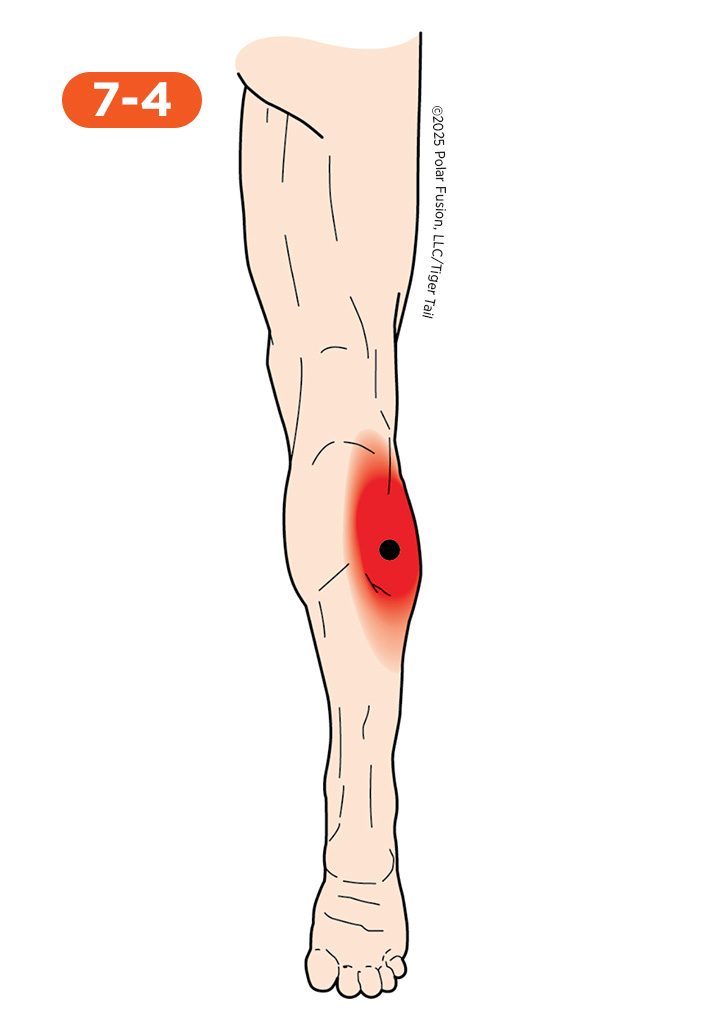
I Feel
Calf Cramps
When you experience painful calf cramps, the root cause is often chronic muscle knots in the large, visible outer calf muscle, the gastrocnemius. The pain typically concentrates high up in the muscle belly and feels like a sharp, intense cramping that can seize the entire muscle and extend along the Achilles tendon. The pain worsens during activities that rapidly stretch the muscle, such as standing up quickly in the morning, flexing your foot hard, or jumping. Since this muscle crosses both the knee and the ankle, its knots can easily mimic deeper issues like a muscle tear or deep vein thrombosis (DVT), which is a serious condition. It causes the calf to feel tight and restricted, leading to stiffness, especially in the morning.

I Feel
Calf Cramps
When you experience painful calf cramps, the root cause is often chronic muscle knots in the large, visible outer calf muscle, the gastrocnemius. The pain typically concentrates high up in the muscle belly and feels like a sharp, intense cramping that can seize the entire muscle and extend along the Achilles tendon. The pain worsens during activities that rapidly stretch the muscle, such as standing up quickly in the morning, flexing your foot hard, or jumping. Since this muscle crosses both the knee and the ankle, its knots can easily mimic deeper issues like a muscle tear or deep vein thrombosis (DVT), which is a serious condition. It causes the calf to feel tight and restricted, leading to stiffness, especially in the morning.
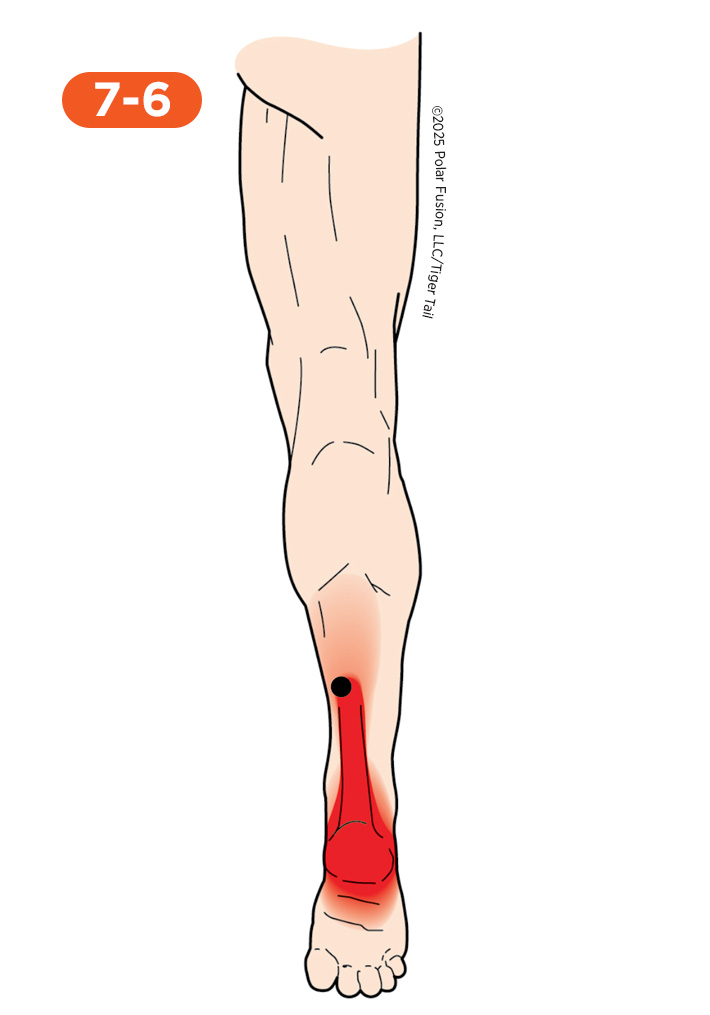
I Feel
Achilles Tendonitis
When experiencing pain like Achilles tendinitis, the underlying cause may be muscle knots in the deep calf muscle, the soleus. The pain feels like a deep, dull ache beneath the outer calf muscle, the gastrocnemius, right at the heel bone, and may sometimes radiate along the bottom of the foot. This discomfort often worsens during activities like walking long distances, uphill running, or standing for long periods, especially when the knee is slightly bent. Since the soleus connects directly to the heel and supports your body weight, its muscle knots can closely resemble more serious issues, such as Achilles tendinopathy or a bone spur. It can cause the heel to feel guarded and restricted, especially during the push-off phase of walking.
Shin Splints
If you’re experiencing pain that resembles shin splints on the inner side of your leg, the actual cause might be chronic muscle knots in the deep calf muscle, the soleus, which refer pain to the front of the shin. The discomfort typically concentrates along the inner back edge of the shin bone, presenting as a deep, pulling ache that can spread throughout the lower inner leg. The pain often worsens during impact activities such as running, jumping, climbing stairs, or stepping off a curb. Since this deep muscle helps stabilize the shin bone, the tibia, muscle knots here can easily mimic more serious issues like medial tibial stress syndrome (true shin splints) or even a stress fracture.
Plantar Fasciitis
Plantar fasciitis typically feels like a sharp, stabbing pain in the heel caused by muscle knots in the deep calf muscle, the soleus. You may feel plantar fasciitis, especially with your first steps in the morning or after a period of rest. It can also feel like a deep ache along the arch of your foot. The pain often improves with a bit of walking but can return or worsen after prolonged standing, walking, or exercise. Plantar fasciitis can also feel like stepping on a pebble or like a tight band across the bottom of the foot.

I Feel
Achilles Tendonitis
Achilles tendonitis can be caused by muscle knots in the deep calf muscle, the soleus. You may feel a nagging ache or stiffness right in the back of your heel, or feel it creeping up into your lower calf, too. It’s often at its worst first thing in the morning or after you’ve been sitting still for a bit, and then it can flare up when you start moving around, especially if you’re doing something like running or even just walking a lot. The spot itself might feel ouchy if you poke it, and it could even be a little puffy or warm to the touch. Some people also describe it as a burning sensation or as a feeling of tightness in the tendon.
Shin Splints
If you’re experiencing pain that resembles shin splints on the inner side of your leg, the actual cause might be chronic muscle knots in the deep calf muscle, the soleus, which refer pain to the front of the shin. The discomfort typically concentrates along the inner back edge of the shin bone, presenting as a deep, pulling ache that can spread throughout the lower inner leg. The pain often worsens during impact activities such as running, jumping, climbing stairs, or stepping off a curb. Since this deep muscle helps stabilize the shin bone, the tibia, muscle knots here can easily mimic more serious issues like medial tibial stress syndrome (true shin splints) or even a stress fracture.
Plantar Fasciitis
Plantar fasciitis typically feels like a sharp, stabbing pain in the heel caused by muscle knots in the deep calf muscle, the soleus. You may feel plantar fasciitis, especially with your first steps in the morning or after a period of rest. It can also feel like a deep ache along the arch of your foot. The pain often improves with a bit of walking but can return or worsen after prolonged standing, walking, or exercise. Plantar fasciitis can also feel like stepping on a pebble or like a tight band across the bottom of the foot.
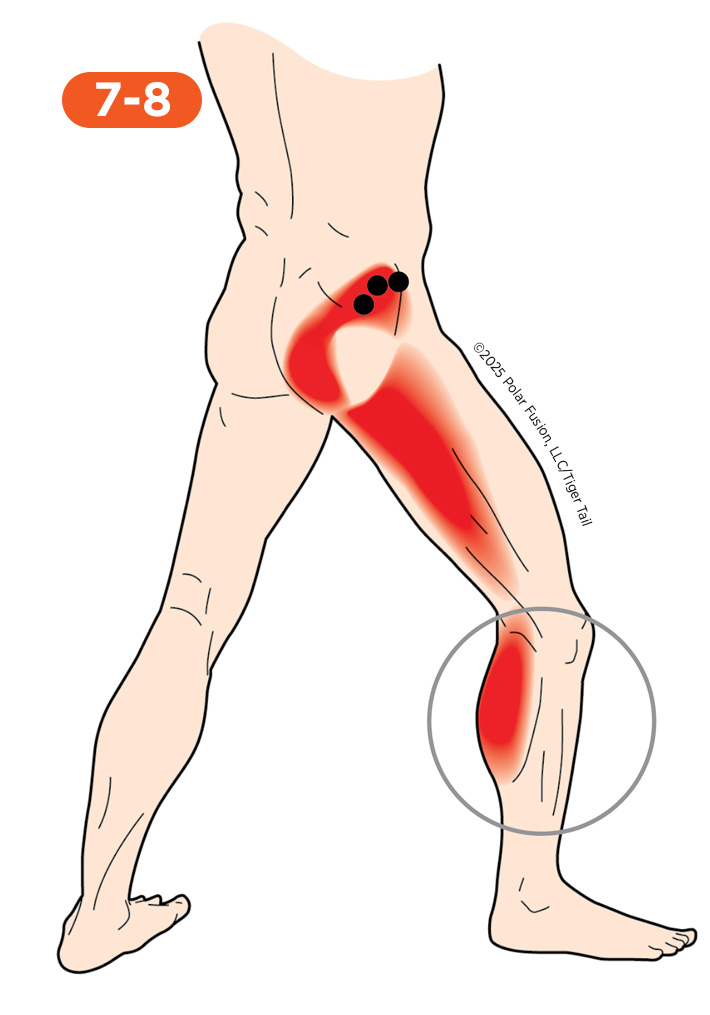
I Feel
Calf Pain
That mysterious calf pain you feel, especially if you can’t find relief by stretching the calf itself, is often referred pain from tight muscle knots in the posterior portion of the gluteus minimus. The discomfort usually focuses deep in the calf, presenting as a burning ache or deep tingle that can run along the back of the thigh and into the calf muscles. You’ll find the pain gets worse when you’re doing movements that compress the hip, like sitting on a hard surface, driving for long periods, or walking quickly. Because this deep glute muscle can irritate the nerve pathways that travel down the leg, its muscle knots can easily mimic deeper nerve problems or a simple calf muscle strain. The muscle knots high up in the side buttocks are often extremely sensitive to pressure, leaving the calf feeling guarded and restricted, even though the problem started much higher up.
